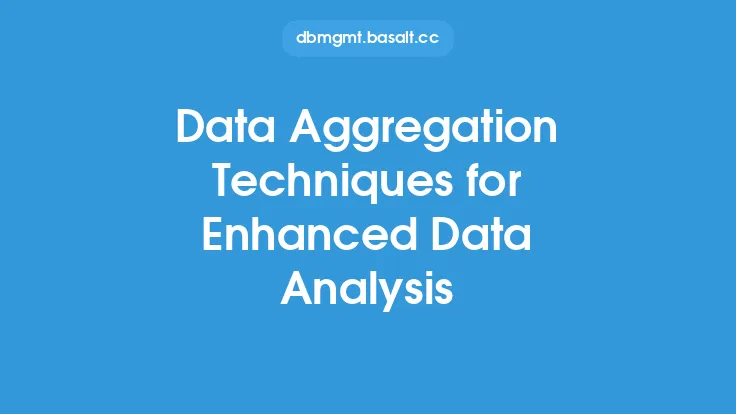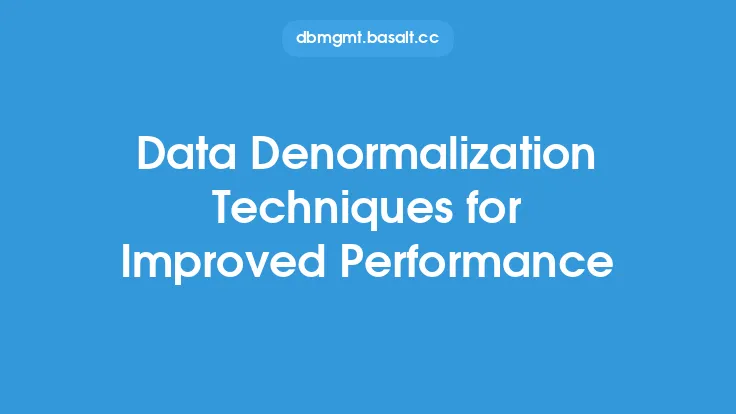Data aggregation is a crucial process in data analysis that involves collecting and combining data from multiple sources into a single, unified view. This process enables organizations to gain insights into their data, identify trends, and make informed decisions. Effective data aggregation techniques are essential for improved data analysis, as they help to reduce data complexity, improve data quality, and increase the accuracy of analytical results.
Introduction to Data Aggregation Techniques
Data aggregation techniques are methods used to combine data from multiple sources into a single, unified view. These techniques can be applied to various types of data, including numerical, categorical, and textual data. The goal of data aggregation is to provide a summary of the data, highlighting key trends, patterns, and relationships. Common data aggregation techniques include grouping, filtering, sorting, and summarizing data. These techniques can be used individually or in combination to achieve the desired level of data aggregation.
Types of Data Aggregation
There are several types of data aggregation, each with its own strengths and weaknesses. The most common types of data aggregation include:
- Rollup aggregation: This type of aggregation involves combining data from multiple sources into a single, summary value. Rollup aggregation is commonly used in financial analysis, where data from multiple accounts is combined into a single, summary value.
- Cube aggregation: This type of aggregation involves combining data from multiple sources into a multidimensional cube. Cube aggregation is commonly used in data warehousing, where data from multiple sources is combined into a single, unified view.
- Grouping sets aggregation: This type of aggregation involves combining data from multiple sources into a single, grouped value. Grouping sets aggregation is commonly used in data analysis, where data from multiple sources is combined into a single, grouped value.
Data Aggregation Methods
Data aggregation methods are algorithms used to combine data from multiple sources into a single, unified view. The most common data aggregation methods include:
- Summation: This method involves combining data from multiple sources by summing the values.
- Averaging: This method involves combining data from multiple sources by calculating the average value.
- Counting: This method involves combining data from multiple sources by counting the number of occurrences.
- Grouping: This method involves combining data from multiple sources by grouping the values into categories.
Data Aggregation Tools and Technologies
Several tools and technologies are available to support data aggregation, including:
- Relational databases: Relational databases, such as MySQL and Oracle, provide built-in support for data aggregation using SQL queries.
- Data warehousing tools: Data warehousing tools, such as Amazon Redshift and Google BigQuery, provide support for data aggregation using SQL queries and data manipulation languages.
- Data aggregation software: Data aggregation software, such as Tableau and Power BI, provide support for data aggregation using visual interfaces and data manipulation languages.
- Programming languages: Programming languages, such as Python and R, provide support for data aggregation using libraries and frameworks.
Best Practices for Data Aggregation
To ensure effective data aggregation, several best practices should be followed, including:
- Data quality: Data quality is essential for effective data aggregation. Data should be accurate, complete, and consistent.
- Data standardization: Data standardization is essential for effective data aggregation. Data should be standardized to ensure consistency and accuracy.
- Data validation: Data validation is essential for effective data aggregation. Data should be validated to ensure accuracy and consistency.
- Data documentation: Data documentation is essential for effective data aggregation. Data should be documented to ensure transparency and accountability.
Challenges and Limitations of Data Aggregation
Data aggregation is not without its challenges and limitations. Some of the common challenges and limitations of data aggregation include:
- Data complexity: Data complexity can make it difficult to aggregate data effectively. Data may be complex, nuanced, and difficult to summarize.
- Data volume: Data volume can make it difficult to aggregate data effectively. Large volumes of data can be difficult to process and analyze.
- Data variety: Data variety can make it difficult to aggregate data effectively. Different types of data may require different aggregation techniques and methods.
- Data security: Data security is essential for effective data aggregation. Data should be secure to ensure confidentiality, integrity, and availability.
Future of Data Aggregation
The future of data aggregation is exciting and rapidly evolving. Some of the trends and technologies that are expected to shape the future of data aggregation include:
- Artificial intelligence: Artificial intelligence is expected to play a major role in data aggregation, enabling organizations to automate data aggregation tasks and improve data analysis.
- Machine learning: Machine learning is expected to play a major role in data aggregation, enabling organizations to improve data analysis and identify patterns and trends.
- Cloud computing: Cloud computing is expected to play a major role in data aggregation, enabling organizations to aggregate and analyze large volumes of data quickly and efficiently.
- Internet of Things: Internet of Things is expected to play a major role in data aggregation, enabling organizations to aggregate and analyze data from multiple sources and devices.





